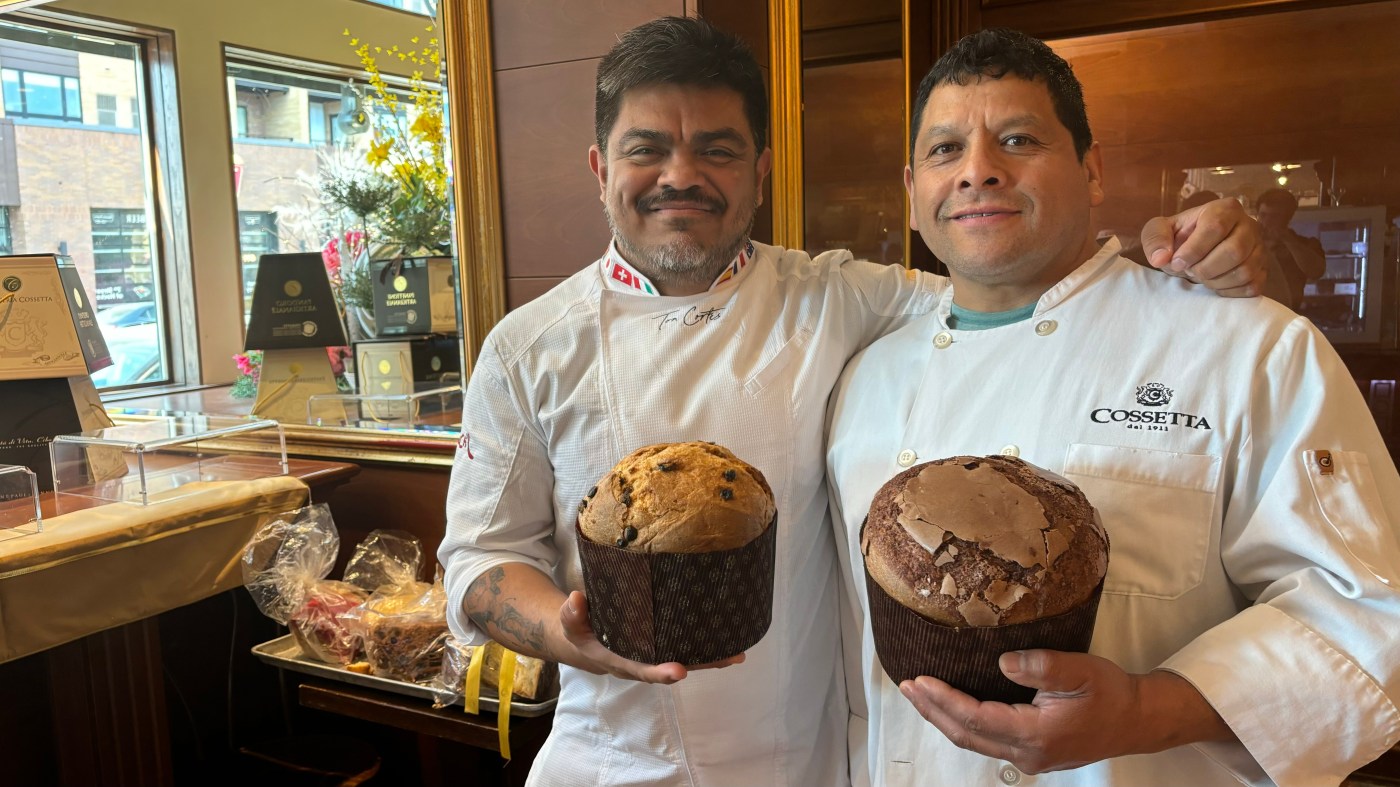
With help from the reigning champion, can Cossetta make the world’s best panettone?
Bakers from Cossetta have never won the panettone world cup — or, at least, not yet.
In late 2023, head pastry chef Jaime Martinez took first place at the U.S. qualifying tournament, which landed him a slot at the 2024 International Coppa del Mondo del Panettone, the world championships, in Milan last November.
Ultimately, he did not make the top three. But who better to call for advice than Barcelona baker Ton Cortés, the guy who won?
So from March 18 through 23, Cortés visited St. Paul’s Italian culinary institution, helping Martinez and the Cossetta team test batches and try new techniques for making panettone, the airy, buttery, fruit-filled Italian bread typically eaten around Christmas.
“We’re looking for perfection,” said Rafael Morán, a pastry chef at Cossetta who works closely with Martinez on panettone. “Our panettone is good — we’re trying to be perfect. When we reach that point, we’ll be happy.”
“Or dead,” added Cossetta’s research and development chef, Elizabeth Drake, with a laugh.
A batch of panettone loaves hang upside-down to cool in Cossetta’s underground bakery on March 22, 2025. Panettone loaves are baked and cooled on specialized racks that rotate, so the butter-heavy bread does not collapse in on itself as it cools. (Jared Kaufman / Pioneer Press)
She’s only mostly kidding: It’s something of an inside joke among old Italian panettone masters that it takes 20 years just to nail down your personal recipe, Martinez said. At Cossetta, they’ve been at it for about 14 years so far, he said.
And making a single batch of panettone can take up to 72 hours. Like sourdough bread, it begins with a fermented “mother” dough. The dough is flavored with orange, vanilla and other ingredients, mixed with candied fruits and set into paper wrappings to bake in a rotating oven. Then, the loaves are moved to specialized racks that flip upside down, so the loaves can cool without collapsing in on themselves — but they have to be flipped back and forth every six hours or so to avoid becoming more dense on one side than the other. Many chefs, including Martinez, use baby monitor-like cameras to watch the process from home when they’re not at work and rush to the kitchen when needed.
“It’s a balance between philosophy and science,” Drake said. “You can follow the same recipe every day and get a different result. You have to get a feel for it; you can’t just rely on the ratios in the recipe.”
Currently, Cossetta’s bakery team only sells panettone at Christmas — and a similar dove-shaped bread called colomba for Easter, on sale now — but they’re considering ramping up to year-round panettone production if customers are interested, corporate executive chef Casey Leick said.
“We’re planning to go big, but Minnesotans have to know what it is,” Martinez said. “We want to build a laboratory just for panettone, but not many people know panettone and what goes into it, so that’s our focus.”
A lineup of several varieties of panettone, made using world champion baker Ton Cortés’s recipes, sit on a counter in Cossetta’s bakery on March 22, 2025. Although the bread is typically only sold at Christmas, Cossetta bakers prepare tests all year round to improve their recipes for the every-other-year international competition. (Jared Kaufman / Pioneer Press)
For a long time, Cortés said, making panettone has been “mystic knowledge kept by just a few Italian masters,” but the world of panettone is opening up. At the 2024 world cup, non-European competitors hailed not just from the U.S. but also Peru, Brazil, Japan and Australia. And Cortés himself, originally from Mexico, did not grow up a baker: He moved to Spain for a well-regarded university program in 14th-century music but graduated, very inconveniently, amid the country’s economic crisis in 2009. He now runs his own bakery, Suca’l, in Barcelona.
And yes, it’s true that making good panettone takes time and practice, he said. But to the extent that he has a “secret” for his world-class bread, it’s to avoid getting bogged down in the process.
“People think that, if something is difficult to do, it’s better, and I think that’s not the case for panettone,” Cortés said in Spanish. “I like to keep things simple and focus on the things that are actually important, like the mother dough: Having a mother dough that’s strong, healthy, well-hydrated, treated with care and attention.”
A loaf of traditional panettone is cut at Cossetta on March 22, 2025. Panettone, typically eaten at Christmas, is fermented with a “mother dough” like sourdough but is sweet, flavored with orange and vanilla and containing candied fruit. (Jared Kaufman / Pioneer Press)
The health of the mother dough is evident when judging the interior of a good panettone, too, he said. The crumb should be light and craggy and the air pockets should be different sizes, signs of good fermentation. The dough needs to be soft, yet strong enough to hold plenty of butter and eggs: Cortés said you should be able to take a slice of panettone and gently tear off a vertical strip in one piece, like you’re ripping a piece of paper — a test called “filato,” or thread, in Italian.
The International Coppa del Mondo del Panettone, the panettone world cup, takes place every other year, so Martinez hopes to compete again in 2026. A team competition, the Campionato Mondiale del Panettone, takes place during the off years, including this October — Cortés is set to captain Spain’s team — but Cossetta is not competing in that tournament.
With his bakery in Barcelona and, increasingly, his panettone-related travel to far-flung places like St. Paul, Cortés’s main goal is to show how versatile panettone can be; that it can be eaten year-round, not just at Christmas.
“What I enjoy the most of making panettone is that it’s about sharing,” Cortés said. “It’s a big celebration bread that you can share with your loved ones, and that is the part I like. And yes, there’s also the freaky part with the temperatures and acidity and baby monitor cameras. You have to be a bit neurotic.”
Related Articles
USDA food aid cuts impact Minnesota schools, child care centers
Do you eat a meal in 20 minutes or less? It might be time to slow down
Lean Cuisine and Stouffer’s meals recalled for ‘wood-like material’ linked to choking
Dining Diary: Potato pancakes and spätzle at Waldmann, dumplings at Ruam Mit and Sunday specials at Brunson’s
Pearl-shaped bubble foods are adding pop to all kinds of menus


